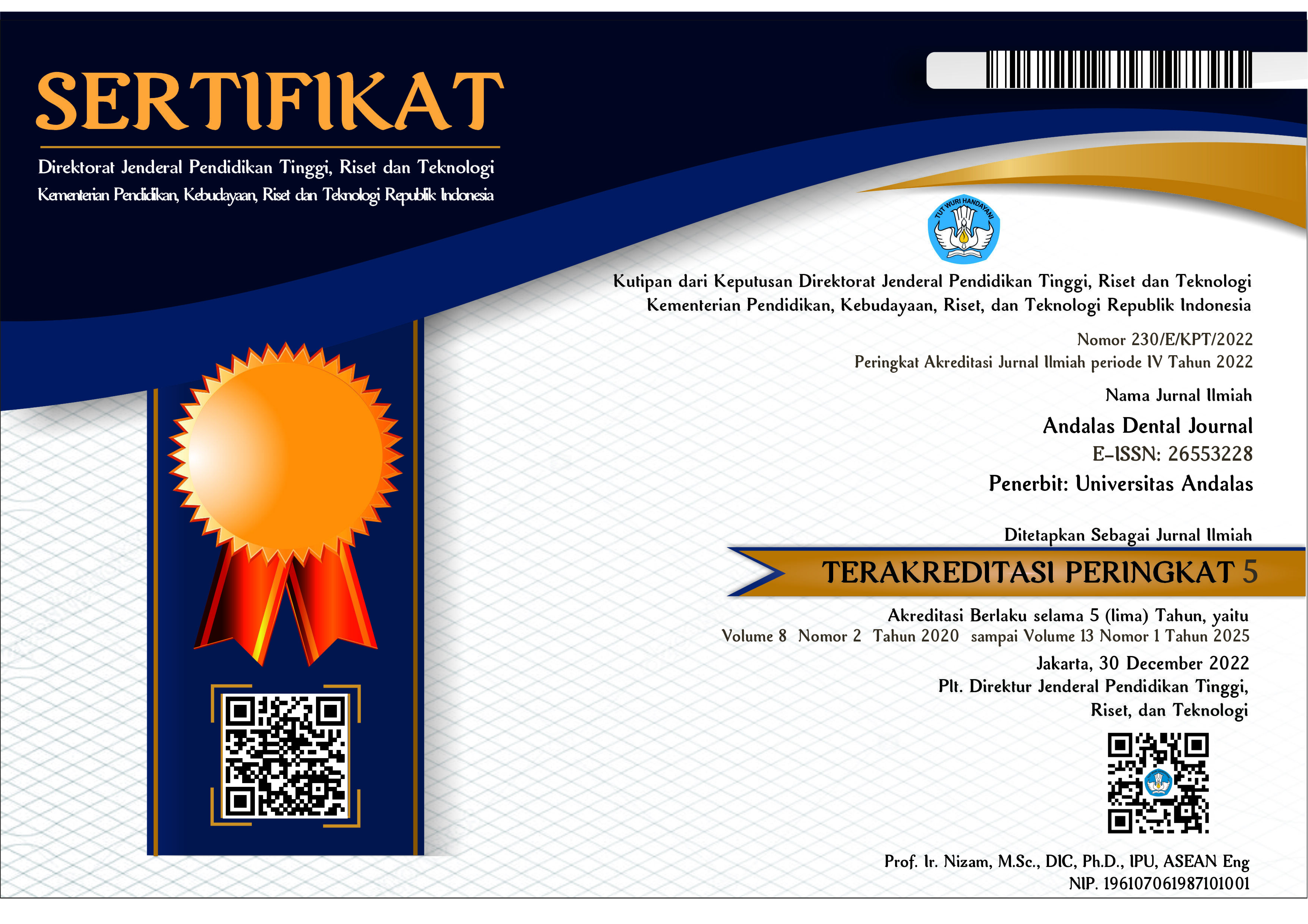Potensi Chitosan Sebagai Bahan Irigasi Dalam Pembersihan Smear Layer Saluran Akar
Abstract
Background: Smear layer is formed after root canal preparation. Removing the smear layer is an important aspect because it can affect the adaptation of sealer so it can increase the leakage of the root canal filling. Chitosan is a natural biopolymer produced by the deacetylation of chitin which has a chelation effect. Purpose: To explain the potential of chitosan as an irrigant on smear layer removal in root canal. Method: Based on sources obtained from journals, textbooks, and websites accessed through the Google Scholar database. The types of references taken are in the form of research reports, literature studies, published from 2014–2021. Conclusion: Chitosan has the potential as root canal irrigant for smear layer removal even in low concentrations with minimal side effects. However, there are differences of opinion regarding the region of smear layer removal.
References
Brady E, Durack C. Root Canal Preparation. In: Patel S, Barnes JJ, editors. The Principles of Endodontics. 3rd Ed. United Kingdom: Oxford University Press; 2020, pp.64–78.
Haapasalo M, Shen Y, Lin JF, Park E, Qian W, Wang Z. Irrigants and Intracanal Medicaments. In: Rotstein I, Ingle J, editors. Ingle’s Endodontics. 7th Ed. North Carolina: PMPH USA, Ltd; 2019, pp.636,641–642,650.
Peters OA, Arias A, Shabahang S. Cleaning and Shaping. In: Torabinejad M, Fouad AF, Shabahang S, editors. Endodontics Principles and Practice. 6th Ed. St. Louis, Missouri: Elsevier; 2021, pp.304–306.
Garg N, Garg A. Textbook of Endodontics. 4th ed. New Delhi, India: Jaypee Brothers Medical Publishers; 2019, pp.65–67,221–232 ,466.
Basrani B, Malkhassian G. Update of Endodontic Irrigating Solutions. In: Basrani B, editor. Endodontic Irrigation Chemical Disinfection of the root Canal System. Switzerland: Springer; 2015, pp.99,103–110.
Marx K. Irrigants and Intracanal Medicaments. In: Gopikhrisna V, editor. Grossman’s Endodontic Practice. 14th Ed. New Delhi, India: Wolters Kluwer; 2021, pp.298–299, 301–305.
Tanikonda R, Ravi RK, Sirisha K. Chitosan: Applications in Dentistry. Journal of Trends in Biomaterials and Artificial Organs. 2014; 18(2): 74–78,
Thomas MS, Koshy RR, Mary SK, Thomas S, Pothan LA. Introduction. In: Navard P, editor. Starch, Chitin, and Chitosan Based Composites and Nanocomposites. Switzerland: Springer; 2019, 3, 259.
Wang W, Xue C, Mo X. Chitosan: Structural Modification, Biological Activity and Application. International Journal of Biological Macromolecules. 2020; 164: 4532–4546.
Berastegui E, Molinos E, Ortega J. To Comparison of Standard and New Chelating Solutions in Endodontics. Open Access Journal of Dental Sciences. 2017; 2(2): 1–8.
Kamble AB, Abraham S, Kakde DD, Shashidhar C, Mehta DL. Scanning Electron Microscopic Electron Evaluation of Efficacy of 17% Ethylenediaminetetraacetic Acid and Chitosan for Smear Layer Removal with Ultrasonics: An In vitro Study. Contemporary Clinical Dentistry. 2017; 8(4): 621–626.
Ratih DN, Rosalia FD, Rinastiti M, Kaswati NM. Effect of Contact Times of Chitosan Nanoparticle as a Final Irrigation Solution on Microhardness and Surface Roughness of Root Canal Dentin. World Journal of Dentistry. 2020; 11(4): 262–263.
Matthew SP, Pai VS, Usha G, Nadig RR. Comparative Evaluation of Smear Layer Removal by Chitosan and Ethylenediaminetetraacetic Acid when Used as Irrigant and Its Effect on Root Dentine: An in vitro Atomic Force Microscopic and Energy-Dispersive X-ray Analysis. Journal of Conservative Dentistry. 2017; 20(4): 245–250.
Neha S, Khurramuddin M, Shekar K, Smitha R, Dola B, Singh V. Effect of Different Irrigation Regimens on Smear Layer Removal in Human Root Dentin an in-vitro Study. Asian Pacific Journal of Health Sciences. 2017; 4(2): 31–37.
Venghat S, Hegde MN. Effect of 0.2% Chitosan in Endodontic Smear Layer Removal: SEM Study. World Journal of Pharmaceutical Research. 2015; 4(12): 1384–1396.
Zhou H, Li Q, Huang W, Zhao S. A Comparative Scanning Electron Microscopy Eveluation of Smear Layer Removal with Chitosan and MTAD. Nigerian Journal of Clinical Practice. 2017; 21(1): 76–80.
Vallabhaneni K, Kakarla P, Avula SSJ, Reddy NVG, Gowd MG, Vardan KR. Comparative Analyses of Smear Layer Removal Using Four Different Irrigant Solutions in the Primary Root Canals - A Scanning Electron Microscopic Study. Journal of Clinic and Diagnostic Research. 2017; 11(4): 64–67.
Darrag AM. Effectiveness of Differet Final Irrigation Solutions on Smear Layer Removal in Intraradicular Dentin. Tanta Dental Journal. 2014: 93–99.
Massoud SF, Moussa SM, Hanafy SA, Backly RM. Evaluation of The Microhardness of Root Canal Dentin After Different Irrigation Protocols (in vitro study). Alexandria Dental Journal. 2017; 42: 71–79.
Öztekin F, Adıgüzel Ö. The Effects of Different Irrigation Agents on Root Canal Dentine Micro-hardness and Surface Roughness. International Dental Research. 2019; 9(1): 16–21,.
Perochena AC, Bramante CM, Duarte MAH, Moura MR, Aouada FA, Kishen A. Chelating and Antibacterial Properties of Chitosan Nanoparticles on Dentin. Restorative Dentistry and Endodontics. 2015; 40(3): 195–201.
Raura N, Gard A, Arora A, Roma M. Nanoparticle Technology and its Implications in Endodontics: A Review. BMC Medicine. 2020; 24(21): 1–8.
Barreras US, Mendez FT, Martinez RE, Valencia CS, Rodriguez PR, Rodriguez JP. Chitosan Nanoparticles Enhance the Antibacterial Activity of Chlorhexidine in Collagen Membranes Used for Periapical Guided Tissue Regeneration. Mater Sci Eng C Mater Biol Appl. 2016; 58: 1182–7.
Copyright (c) 2023 Rina Permatasari, Erisa Ekiyo

This work is licensed under a Creative Commons Attribution-ShareAlike 4.0 International License.















